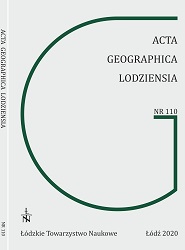GEOCHEMISTRY OF A SEDIMENTARY SECTION AT THE WĄWELNICA ARCHAEOLOGICAL SITE, SZCZECIN HILLS (WESTERN POMERANIA)
GEOCHEMISTRY OF A SEDIMENTARY SECTION AT THE WĄWELNICA ARCHAEOLOGICAL SITE, SZCZECIN HILLS (WESTERN POMERANIA)
Author(s): Daniel Okupny, Ryszard Krzysztof Borówka, Bernard Cedro, Joanna Sławińska, Julita Tomkowiak, Adam Michczyński, Dorota Kozłowska, Krzysztof Kowalski, Krzysztof SiedlikSubject(s): Archaeology, Physical Geopgraphy, Applied Geography
Published by: Łódzkie Towarzystwo Naukowe
Keywords: biogenic accumulation basins; drainless areas; geochemistry; human impact; Holocene; Szczecin Hills;
Summary/Abstract: The results of geochemical assays on biogenic sediments filling a fossil lacustrine basin at Wąwelnica, in the Szczecin Hills, within the left-bank part of the Oder River catchment are presented. The data reveal a natural Holocene sedimentation se-quence similar to that found for other sites in central Europe. The geochemical record of palaeo-environmental changes, which may be a consequence of human activities in the proximity of the site, is distinctly bipartite. The part of the profile corresponding to the lacustrine sediment accumulation during the Greenlandian occasionally shows an increased mineral content and an elevated catchment erosion index. An incidental presence of Palaeolithic and Mesolithic communities is confirmed by archaeological evi-dence from a few sites in the Szczecin Hills. More distinct episodes of mineral matter supply and more pronounced changes in geochemical indicators can be inferred as occurring from the onset of the older part of the Atlantic until the Older Subboreal. Most of the flint artefacts discovered along with a collection of vessel fragments in the Mierzyn-Dołuje area are associated with the Neolithic occupation. However, changes in the deposits’ geochemistry do not reflect all the settlement stages associated with the consecutive human groups identified by archaeological evidence. Possible reasons include a low sediment accumulation rate hav-ing restricted peat mass accretion and prevented the storing of any higher amounts of water. This, along with the climate-change-caused lowering of the water table, could have periodically stopped the accumulation of autochthonous organic matter. In addition, intensified human activities coincided with periods of stable and low water level in the basin. On the other hand, breaks in human activity correspond with moist Holocene stages and local flooding events.
Journal: Acta Geographica Lodziensia
- Issue Year: 2020
- Issue No: 110
- Page Range: 169-189
- Page Count: 18
- Language: English

